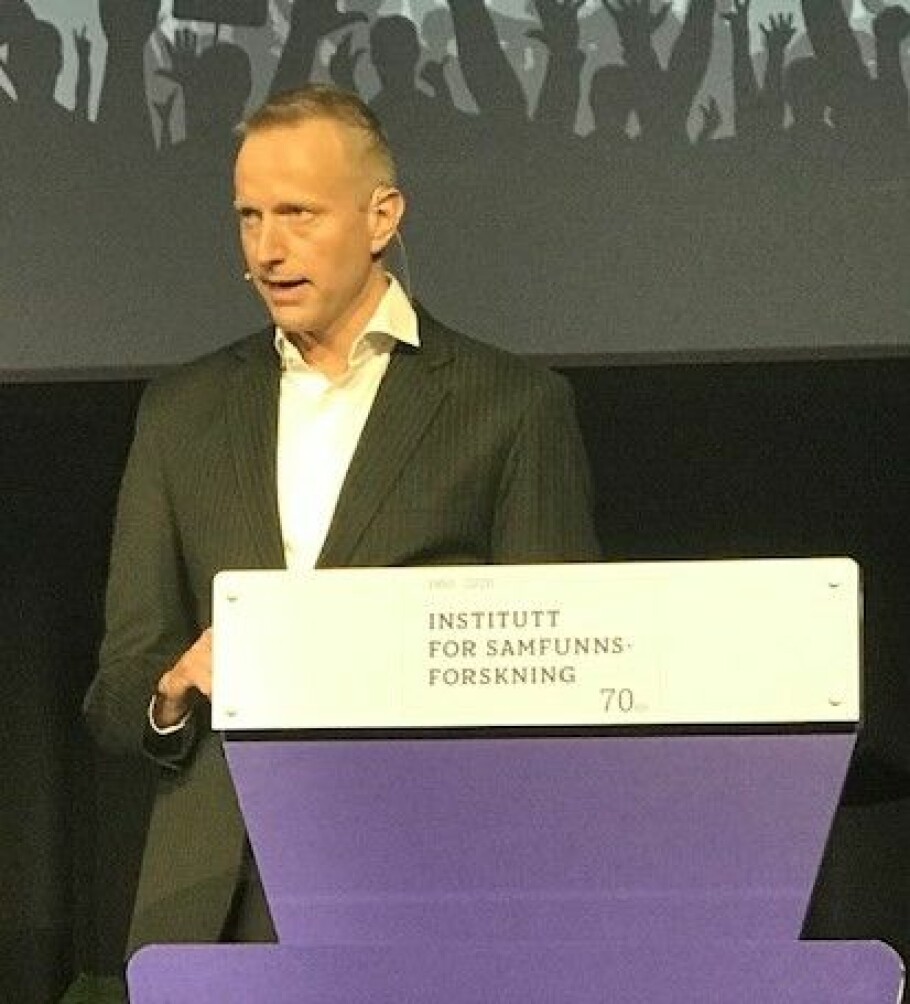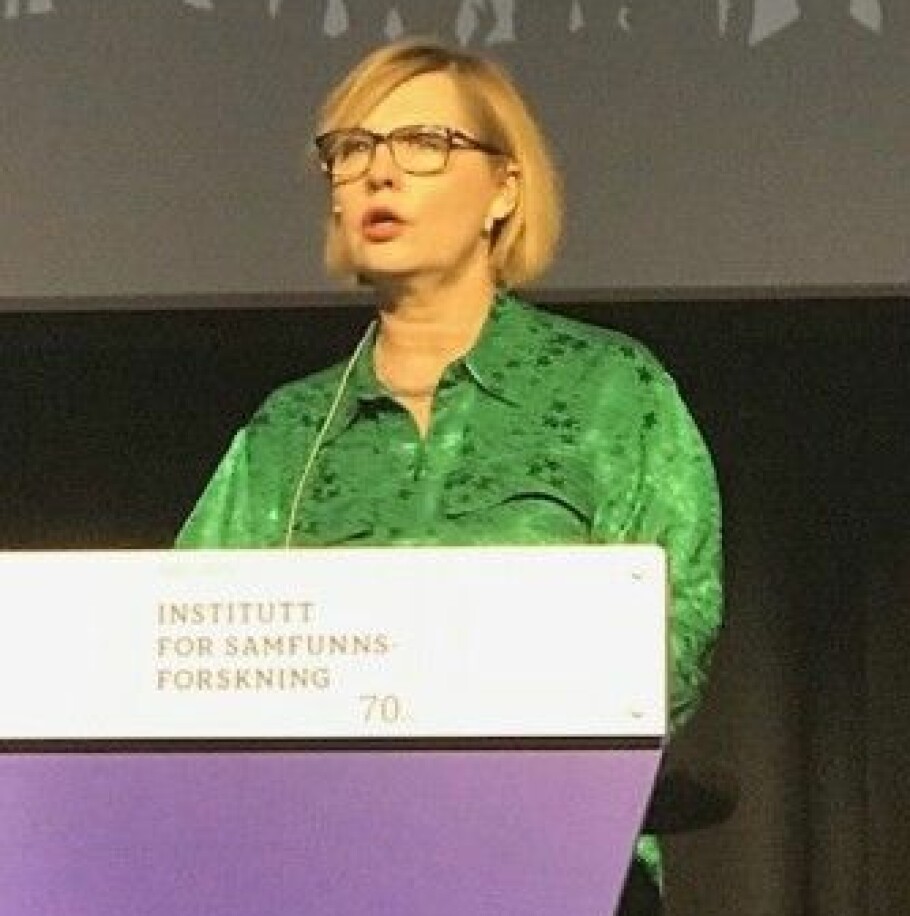
Is Norway becoming a polarized country?
Polarization and populism have created major problems in many parts of the world. Norwegian social scientists see warning singnals also in Norway.
We see it in the rest of the world. People seem more divided than before in their views of economics, minorities, immigration and equality.
There is also a lot of talk here in Norway about these issues. Claims are made that we are becoming a more polarized society with increasing divides on important issues in society.
In February, the Institute for Social Research (ISF) celebrated its 70th anniversary with an anniversary seminar.
The theme was: Is our society becoming more polarized?
Some of the answers from the line up of researchers who gave talks were perhaps a bit surprising.
Have studied old studies
Johannes Bergh is a researcher at the ISF and works on topics such as political participation, elections and political mobilization of youth.
"Authoritarian populism had a greater potential in the 1950s than today," says Johannes Bergh.
He has returned to the first major social science project at the ISF, the Nationalism Project in the 1950s.
At that time, researchers were concerned with many of the same questions that the researchers at ISF are working on today. They studied nationalism, authoritarian attitudes and views of minorities. Polls were not so common in the early 1950s, but ISF researchers were ahead of their time. They conducted a poll of Oslo's inhabitants in 1952.
One claim that respondents were asked to agree or disagree with was:
“What we need most here in our country, more than laws and programs, are a few selfless leaders with authority that the people can safely follow. This must be at the heart of authoritarian populism. "
As many as 37 per cent fully agreed with this claim in 1952.
In the 2017 Election Survey, researchers at ISF conducted a similar, but milder, formulated question.
Then only 11 per cent agreed completely.

Negative view of minorities
Another element of populism is a negative view of minorities.
"It is problematic to compare attitudes in the 1950s with today. Society has changed radically ever since. But if one is to compare the view of a minority today and 70 years ago, there must be a group that was relevant and known to the population, even then. The Jewish minority in Norway is one such group,"says Bergh.
Researchers in the 1950s studied negative stereotypical attitudes toward Jews, anti-Semitism, through claims like this:
"A lot of the reason for why Jews are often persecuted is their own fault."
In 1952, 44 per cent responded that they agreed with this claim. 22 per cent responded that they disagreed.
"Shortly after the war, when the Holocaust was known, more people agree rather than disagree with this claim," Bergh points out.
The Center for the Study of the Holocaust and Vision Minorities, posed an almost identical question to the Norwegian population in 2017.
Then 8 per cent responded that they agreed, while 70 per cent disagreed.
"There is no doubt that Norwegian society has changed radically during these 70 years in the direction of a rejection of authoritarian attitudes and towards a more positive view of the minorities," says Bergh.
"Authoritarian populism had a greater potential in the 1950s than it does today," he says.
Also sees danger signals
"Studying Norwegian people's attitudes over time can correct the most bleak descriptions of today's society,"Bergh says.
But he is not overly optimistic. It's easy to see the danger signals if we look for them.
"It seems that the development in Norway in recent years is part of an international trend where polarization and populism have created significantly greater problems in countries other than Norway."
"We cannot ignore the fact that the development in recent years may accelerate and that we may enter a wicked spiral where polarization creates insurmountable distances that make excercising politics and governing difficult."
This, in turn, may lead to dissatisfaction with the political system, which in turn can provide the basis for increased populism.
"But right here and now there is reason to see the relatively mild polarization and populism in Norway as a plus", he says.
Toll road can play a positive role
He uses ThePeople's Action No to More Road Tolls party as an example that populism can also have positive sides.
"This party expresses a form of populism. They criticized the established parties and claimed to speak on behalf of ordinary people."
At the same time, the No to More Road Tolls party uses the established political institutions in Norway, according to Bergh.
They stand for election and aim to exercise power through established political institutions. And they express opinions that many voters have. These voters are given the opportunity to express their frustrations and anger through the ballot.
"Thus it can be said that the No to More Road Tolls party has had a positive role in Norwegian local democracy," says Bergh.
But polarization can also create major and entrenched conflicts in a society.
"It can, for example, make it difficult to make compromises which in turn may damage the political system," says Bergh.

Is anti-feminism on the rise in Norway?
Equality is a value almost everyone agrees on, says Mari Teigen, researcher at ISF and head of the Center for Gender Equality (CORE).
At the same time, we have seen that gender equality can have a polarizing effect in many countries.
National populist parties have gained support in much of Europe, Brexit has fueled racism and discrimination in the UK, Trump and the Tea Party movement have made gender-traditional values thrive in the US and President Bolsonaro in Brazil has made fighting so-called "Gender ideology" into a top priority.
Why is anti-feminism and gender equality on the rise in large parts of the world? Is this also happening in the seemingly equality-loving country of Norway?
"Some will answer yes," Teigen says.
The Norwegian debate about abortion legislation, fetal reduction and the right of doctors and nurses to reserv their right to not participate in abortion procedures has drawn inspiration from new policies in other countries, she believes.
"Some would also say that prime minister Erna Solberg's New Year's Eve speech last year, which encouraged women to have more children, left us with a taste of anti-gender-equality."
Has equality come far enough?
15 years ago, in 2005, Teigen conducted a study in which she found increasing signs of polarization in the population on attitudes towards equality.
Her question was: Do you think that equality should be pursued, has it advanced far enough, or has it advanced too far?
In the 1980s, just over half, both women and men, responded that gender equality should be expanded. In 1993, support for gender equality had fallen and there were clearly more women than men who believed that gender equality needed to be advanced. In 2001, the gap between women and men had increased even more.
When Teigen was to do the survey again in 2019, she expected that the gap between men and women and whether they wanted gender equality to advance would have continued to increase and that more men would believe that gender equality had gone far enough.
Her expectations did not materialize.
Support for the advancement of gender equality had increased.
This applied to both men and women. Admittedly more among women, but the proportion of men who believe that gender equality should be advanced has clearly increased. Especially if comparing to the figures from the 1990s.
Still, Teigen doesn't think we should be calm.
"Anti-feminism, social media and right-wing populist mobilization in a number of countries may gain ground in the Norwegian debate", she warns.

Polarization in working life
"The most important reason behind polarization is found in the labour market," says Erling Barth, who has researched new technology, the labour market and the welfare state at ISF.
The robots will primarily take over the jobs that are in the middle of the pay pyramid.
"Many professionals in the industry and many secretaries and middle positions in banking and finance will disappear," says Barth.
"When were you last in the bank talking to a human? What happened to these professions?" he asks.
In the 1970s, there was an increase in jobs at the top of the wage pyramid, while jobs at the bottom decreased. Then there was a rupture in the late 1990s.
Jobs at the top continued to increase, and jobs at the bottom increased, while jobs in the middle declined.
The reason for this is that the professions at the bottom are not easily taken over by a computer. These are jobs within hotels and restaurants, healthcare, baristas, personal trainers and so on.
"When growth is happening in the competence professions, it's easy to know what to do. Then we can only upgrade the competence of the population and focus on education and retraining," says Barth.
"But with this polarization which gives more low-paying jobs in the labour market, it's worse. Many in the middle lose their jobs. It may not be as easy for an industrial worker to work in day care or for the bank clerk to become a barista," he says.
Minor consequences in Norway
We don't know exactly why this is happening, according to Barth.
"Most international studies point to digitization and robotization," he says.
Globalization is also contributing, many industrial jobs are being moved abroad.
"We do not know what will happen, whether it is the jobs at the top or the bottom that will be hit next time. The only thing we know for sure is that there will be major changes in the future as well," says Barth.
There are increasing inequalities in the Nordic countries as well, but this may have less consequences in these countries than in other countries, the researcher believes.
For example, Norway has strong trade unions and employers' organizations that contribute to relatively small pay differences in the Nordic countries compared to other countries.
"We also have generous insurance schemes in our countries that reduce inequality and help reduce polarization," says Barth.
"When jobs get lost, as a society, we split the cost of covering those affected. That makes the uncertainty less than in countries that have weaker welfare schemes," he says.
The picture is composed
At the end of the seminar, Tanja Storsul, director of ISF, was given the task of summarising the seminar - and answer the question of whether Norway has become a more polarized society.
Her answer was both yes and no, or rather 'perhaps'.
"We see some trends that show that we are getting more polarization", Storsul said.
"At the same time we see areas where it is not so prominent."
Translated by: Ingrid P. Nuse
———


































